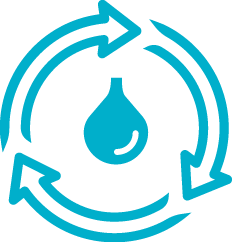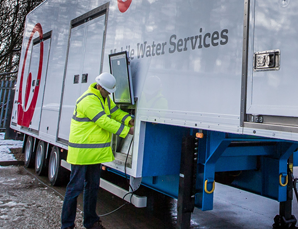Mine Water Management Best Practices
Veolia's mine water treatment expert, David Oliphant, shares his thoughts on mine water management strategies and best practices.
What are some of the biggest challenges in mine water management today?

Specific strategies of mine water management depend on various factors, primarily the water balance of the site being a main driver. In areas, such as Canada, where water supply is plentiful, the mine will benefit from a positive water balance but may face risks such as flooding. By contrast, in areas with a negative water balance, such as dry desert areas with low rainfall and high evaporation, water conservation and recycling will be essential. Whatever the situation, strategies need to mitigate against negative impacts and take account of the needs and concerns of local communities, ideally working closely with them. Immediate corrective action, where needed, is invariably better than retroactive steps.
Another area is uncertainty related to climate change. Most people agree that climate is changing, but how it will impact a specific location in 10, 20 or 30 years is quite difficult to evaluate. Climate change may change the mine's water balance significantly, making a positive balance negative, or exacerbating dry or wet events. For example, in certain areas of the world, we are starting to see permafrost starting to melt.
Finally, the ever-tightening regulations regarding constituents of concern that are generally ignored at the moment. Things like PFAS, selenium, thallium, sulfate, chlorides and generally ever-lower metal concentrations, even some below typical external lab detection limits. Not many mines have criteria for these at the moment, but regulation for these may be coming sooner than expected. Will existing water treatment facilities be able to deal with these? That's something that mining companies need to keep a close watch on.
What opportunities are available if mines manage their water well?
Good mine water management can be positive in many ways. It prevents the accumulation of pollutants within the water held on site, such as in tailing ponds. Management of the pollutants from the start will eventually help prevent expensive water management in the future, where technologies could be used to treat a very concentrated mine effluent.
In order to manage water properly, mines should constantly monitor what is going on. How’s the weather? How do last year's precipitations compare with the predictions we used in the development of the mine water management strategies? How are we disposing of the waste rock and tailings? Are we following the plan? How is the water quality compared to the quality predicted by the geochemical modeling? It is rare that these things change suddenly, and usually, you can get a couple of years of heads up if you do proper monitoring which ultimately gives you time to adapt.

Water reuse opportunities
It is becoming imperative for mining companies to seek and implement sustainable solutions for a cleaner, greener environment. In coping with the ever-growing challenges of water management and demand, the mining industry relies increasingly on cutting-edge and innovative technologies, improved management systems for water efficiency, and more sustainable mine water management. Advanced modern facilities to reclaim and reuse water are rapidly being developed and widely implemented for better resource management and water conservation. The economic and environmental benefits of using reclaimed water are tangible, as both raw water consumption and the discharge of contaminated wastewater can be significantly reduced. This can also increase overall water availability – a major step towards greater water self-sufficiency, ensuring a stable and continuous water supply for expanding operations.
Which services and technologies does Veolia offer for mine water management?
Veolia offers a holistic approach to mine effluent treatment –from initial water quality, discharge criteria and specific site conditions to a complete mine water treatment plant specifically designed for a mine site's needs. We partner with exploration, engineering, and mining companies to solve even the most difficult mine water challenges. We provide a full range of mine water treatment services including preliminary and detailed engineering, standard and custom water treatment equipment, maintenance support, chemicals and mobile water treatment options.
A Focus Mobile Water Treatment Options:

For mining operations, effective mine water treatment is about more than meeting regulatory requirements and maintaining a social license to operate. Choosing the right approach to water treatment can have a profound impact on a mine’s business. One increasingly attractive option for mining companies is the deployment of Veolia’s mobile water treatment technologies.
Often considered as a temporary or emergency solution where an existing plant has failed, or an unforeseen situation has arisen, mobile assets are also ideally suited to use during planned commissioning, refurbishment or maintenance projects and even for longer-term water treatment requirements, such as during decommissioning and site remediation.
For the junior mining sector in particular, one of the perennial challenges is the provision of capital. The nature of such a business means that when raising capital in the marketplace there is a strong focus on securing funding for revenue-generating equipment used in ore processing within the mill. With the focus of major capital purchases centered on the mill, capital expenditure for water treatment is more challenging.
Mobile water treatment makes an attractive solution as it can be more easily financed through the operational expenditure budget on a month-by-month basis during the construction and development phases. This is also quite attractive as this also gives regulators confidence of the process when the client goes from a temporary solution to a permanent one. With the mobile assets already proving they can meet discharge regulations, it is much easier to permit the technology for long-term operations. Also, once operations are successfully generating income, investment in permanent water treatment facilities is more manageable.
Recommended Article: Moving Mining With Mobile Water Treatment
Has there been an increased interest in solutions such as water treatment and zero-discharge systems in recent years as ESG moves up the agenda for mining companies?
Among the key challenges facing the mining industry are not only the management of water resources but increasingly stringent regulations – many of them water-related – and declining ore grades, which also impact the industry’s water needs. Together these give rise to a set of interrelated concerns which include water availability; the need for sound water management strategies and models; compliance with stricter regulations on water quality; the need for more detailed reporting to stakeholders on water management and associated risks; and tailings management. Water issues also need to be taken into account as part of mine closure strategies following the active life of the mine.
Mining ventures are often massive investments, and investors require assurance of the security of water supply to meet their needs at a viable price. Water can take up a significant share of a mine’s capital expenditure and operating costs. The availability, quality, and cost of water are key to investment decisions, and cost-effective water usage is critical to profitability. Given this, mine operators around the world are increasingly aware of the need to conserve the environment and focus more and more on their ESG goals. Faced with the challenges posed by climate change, many have been searching for more sustainable methods and processes for using water. Given the ubiquitous role of water in mineral processing, systematic and extensive improvements are leading to lower impacts on the environment.
The efficient design of facilities and optimization of processes not only save water but also help achieve cost savings and contribute to better maintenance of facilities. Planning and monitoring of water balances and water usage allows correction of inefficiencies in the usage of water. Maintaining close supervision and tight control of these factors enables facilities to be optimally utilized while conserving resources.
Why are best practices in mine water management so important to the sustainability of the mining industry?

Environmental/Financial/Community Aspects
More stringent environmental regulations and higher community expectations are putting pressure on mine operators to adopt ever more intensive management of their water usage. Good mine water management helps make a mining company attractive to investors and is a boon in obtaining access to water resources. Employees prefer mining companies that pay attention to issues such as water quality control, making it easier to recruit and retain staff. Similarly, a company practicing strong water management is viewed positively by the local community – enjoying the so-called social license to operate. Risks related to inadequate water management in mining are not limited to operational risks; they also have strategic implications for mining companies, such as loss of investment attractiveness and damage to a company’s social license to operate.
Long-term strategy plans
At the end of their productive working lives, it is vitally important to ensure that mines are managed in a manner that mitigates or eliminates any potentially adverse effects. In practice, this means that the owners of individual abandoned or closed mine sites often have a duty of care to protect the natural environment - both in and around the area. They need to make every effort to eliminate the possibility of any negative impacts, which can include contamination of the surrounding land and surface watercourses, as well as the pollution of local groundwater supplies and drinking water aquifers.
In doing so, the deployment of an effective mine water treatment strategy is likely to form a key component for effective mine closure, reclamation and community acceptance of the site. This is chiefly because contaminated water at closed mine sites can contain a range of harmful and toxic substances and dangerous chemicals, as well as metals such as cadmium, nickel, iron, copper and zinc. Such materials will tend to vary depending on the nature and location of the mine site. Furthermore, water at abandoned mine sites can be highly acidic, which can pose a dangerous threat to human, animal and plant life.


